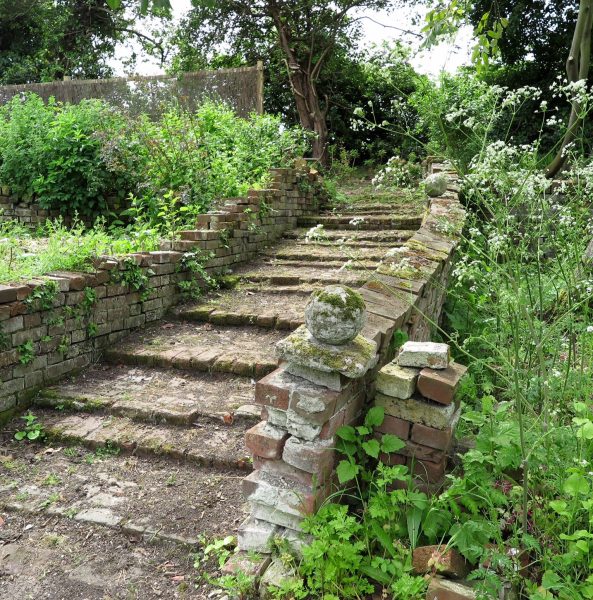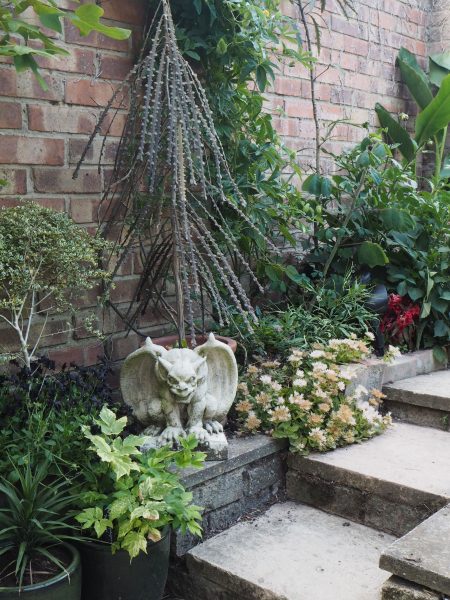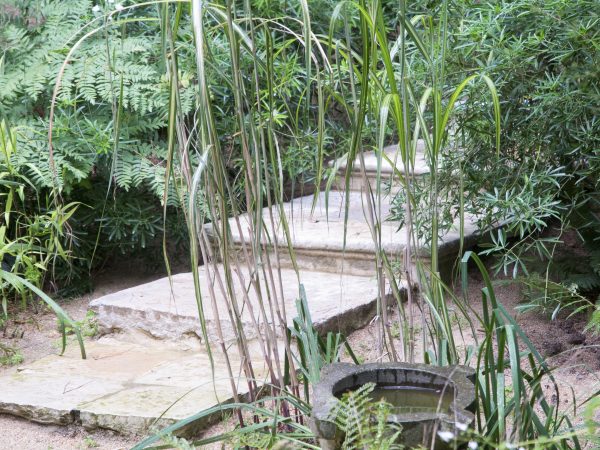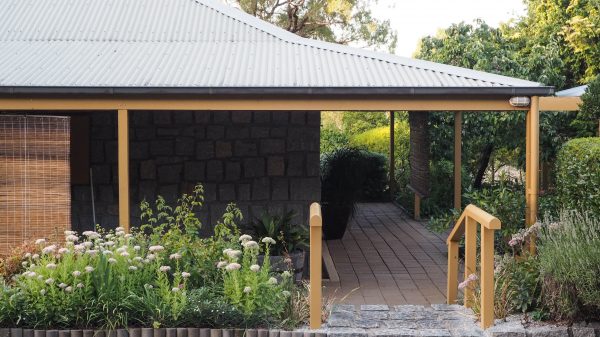How To Fix Steep Steps In Garden
What you need to know about garden steps
July 21st, 2019 Posted In: Garden trends & design, Town gardens
Garden steps are not the same as the stairs inside your house. That's probably the most important fact you need to know.
Even qualified architects sometimes make that mistake. So even if you have architects or hard landscapers installing your garden steps, it's worth knowing the outlines of what ought to happen.
Once you know the important facts, you can have all the fun of choosing the design.

I adore these steps at Gravetye Manor in Sussex. Perhaps it's the way they curve so invitingly upwards.
How steep can garden steps be?
The two terms you need to know are 'riser' and 'tread.' Unsurprisingly the riser is the vertical bit – it's how high each individual step rises.
The 'tread' is the flat part of the step, where your foot lands.
Indoor stairs have a typical riser of 17-18cm with a tread of 22-24cm. They're also required to have handrails, and there's usually a wall to support you.
Risers for outdoor steps should be no more than 15cm high. Their tread should be 30cm deep. They often have no handrail or walls to support them, so they need to be easy to go up and down.
How many garden steps do I need?
Before you choose the style of your steps, you'll need to work out how many you need as that affects your budget. Divide the total height between the two spaces you are connecting by 15cm if that's your desired riser height. Or if you want lower, flatter outdoor steps, then you can have risers as low as 9-10cm.

The steps from our terrace to the main lawn. Writing this post has made me realise they are just a couple of centimetres too high. And now I think about it, they're not as comfortable as the front steps, which are 12cm and 14cm high.
You can work out the total height by using a piece of string, either held by someone or tied down, on the higher level. Make sure it's level!
For example, my garden has steps up from the terrace to the lawn. The lawn is 40cm (1ft4″) higher than the terrace. The steps were here when we moved in. And while writing this, I've discovered that the riser height is just under 20cm. It's just a bit steep for comfort, although we are used to it. This is presumably because two steps with 20cm risers was more convenient than three steps at 9cm each.
Then work out how wide you want or need the steps to be. Usually, the wider the better if you want a spacious feel to the garden. And wide steps can also look wonderful if they're flanked with pots.
And our steps are three pavers wide, so that's a total of six pavers required.
Garden steps with gravel
If you want gravel steps, you'll need a secure way of containing the gravel so it doesn't wash away.
Even so, gravel heights change as bits of gravel get taken away on people's shoes or the gravel settles. If that happens, you could find that the edge of the tread rises up, creating a small trip hazard.

Thomas Hoblyn's garden for Dubai Mailis at the RHS Chelsea Flower Show 2019. The risers are stone and the treads are shingle/gravel in the same stone. It's a pretty effect.
Garden steps with stone
Stone is a beautiful, hard-wearing (and expensive) option. You can use granite, limestone, sandstone, Yorkstone or whinstone.
Choose from finely finished or roughly dressed. Take the thickness of the stone into consideration when calculating the riser measurements.

Formal stone steps in the Sunk Garden at Doddington Place Gardens (open Sundays and Wednesdays April-September). These steps are at least a hundred years old – stone really lasts.
You can also have stone-effect pavers made with concrete or other man-made materials. Check that they're suitable for outdoor steps before ordering them.

These steps in my garden have brick risers and sandstone treads.
Brick steps
There are lots of bricks that are manufactured for steps. They are hard-wearing and frost-proof. So when choosing bricks, check whether they're suitable for steps.
And consider the architecture of your home when choosing brick steps. In the UK we have yellow bricks and red bricks, so bear that in mind when choosing which colour brick you want for your steps.

These beautiful brick steps are over 100 years old. They have now been repaired, but I rather love this romantic dilapidation.
Timber garden steps
There are two problems with timber steps. Timber rots over time and it gets slippy in the wet. However, if you're happy to keep a close eye on maintenance, it's a budget-friendly option, especially if you install it yourself.
People used to buy railway sleepers for steps, but this is now not recommended because of the levels of creosote.
Garden steps for steep slopes
It's generally considered a good idea to break up a very long run of garden steps. If you can design in a 'landing' or have a ramp for some of the distance, it will look better and be more comfortable to climb. Ramps should rise at a gradient of 1:12. That means they should rise one metre over every twelve metres.

There are steep slopes at Gravetye Manor in Sussex, so these steps are broken up by lengths of ramp to make them easier and more comfortable to climb.
More garden step ideas

Mark out steps with statues or sculpture. This is Philip Oostenbrink's garden in Ash, Kent, open twice a year for the NGS.

Or use wide garden steps to display pots as seen in Robin Grimble's garden. It often opens for Faversham Open Gardens on the last Sunday in June every year.

More shallow steps at Le Jardin Agapanthe in Northern France. The stone closely matches the shade of the sand they are set in.

These garden steps are recycled industrial steps. Seen in the Walkers Forgotten Quarry Garden by Graham Bodle at RHS Chelsea Flower Show 2019.
See more of these garden steps in video
You can always see more of a garden in a video:
Garden step safety
A single garden step can be a trip hazard if people don't see it easily. Consider using a contrasting material so that people can see it more easily.

This single step is clearly marked by a change of use in the materials. Seen in the Glimpse of South East Asia Garden at BBC Gardeners World Live.
You don't necessarily need handrails for garden steps, but they can be designed in to go with the garden.

When Robin and Margaret Marks added a handrail to their front garden steps, they made it part of the design by painting it the theme colour for their house and garden. It looks great.
If you're accessing the garden via stairs – for example, you reach a basement garden from a ground floor door – then you can treat those as 'indoor stairs'. But with risers of 18cm, they need bannisters and handrails!
And when stone or concrete pavers are being installed as steps, check the overhang. That's the tiny amount of paver that juts out over the riser. If there is too big an overhang, and the steps aren't securely fixed, then the paver could flip up when you tread on it. It doesn't often happen, but it would be a nasty accident if it did.
More garden design tips
Steps and paths are inextricably linked, so do check out Garden path materials – the good, the bad and the beautiful. And if you're wondering how to find the right professionals to landscape your garden – or if you've got other landscaping questions, then see Matt Jackson of Land & Heritage consultancy's 12 professional insider tips for landscaping your garden.
Shop my favourite garden tools, books and products…
I'm often asked for recommendations, so I've put together some useful lists of gardening things I use myself for the Middlesized Garden Amazon storefront.
Note: Links to Amazon are affiliate, see disclosure.
Pin to remember garden steps essentials
And do join us on the Middlesized Garden every Sunday morning for tips, ideas and inspiration for your garden.

How To Fix Steep Steps In Garden
Source: https://www.themiddlesizedgarden.co.uk/what-need-know-garden-steps/
Posted by: allsupwhady1948.blogspot.com

0 Response to "How To Fix Steep Steps In Garden"
Post a Comment